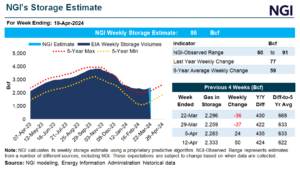As Cooling Demand Mounts, Natural Gas Futures Notch Third Consecutive Day of Gains
Soaring summer temperatures and increasing expectations that this month will prove one of the hottest Julys on record boosted natural gas futures on Tuesday and extended the current rally to three straight trading days.

The August Nymex contract settled at $1.876/MMBtu, up 4.6 cents day/day. September rose 4.6 cents to $1.939.
NGI’s Spot Gas National Avg. rose 8.5 cents to $1.750.
Forecasts for above-average heat across the Lower 48 is driving cooling demand and curtailing the risk for storage containment this fall. This, in turn, is lifting sentiment and galvanizing markets despite continued spread of the coronavirus, an uncertain economic outlook and enduring concerns about weak liquefied natural gas (LNG) demand.
Bespoke Weather Services said Tuesday that gas-weighted degree days (GWDD) are projected to reach record levels over the 15-day outlook.
“Our projections now show that, even assuming normal for the final 10 days of the month, this July will eclipse 2011 and 2012 as the hottest July on record in terms of national GWDDs. We are not seeing record temperatures in any one given region, but it is just hot over such a large portion of the nation,” with temperatures ranging from the high 80s into the 100s.
“Given that the La Niña base state is digging in,” the forecaster added, “odds continue to favor heat sticking around for the balance of the summer season, giving us a shot at challenging 2010, 2011 and 2016 as the hottest overall summer on record based on GWDDs.” The heat, Bespoke said, is “boosting power burns, which is something likely to be a mainstay for the balance of summer, in our view.”
Meanwhile, Tuesday production data showed a decline, the firm added, primarily due to maintenance work in the Northeast. While maintenance-related declines are typically short lived, it “certainly helps combat the continued very low LNG volumes we are seeing,” Bespoke said.
EBW Analytics Group agreed. “LNG feed gas demand to start July is likely to remain a bearish undercurrent for gas through the heart of summer,” the firm said Tuesday. July feed gas demand has sunk 1.2 Bcf/d from the June average demand, averaging only 2.9 Bcf/d so far in July. A daily low of 1.8 Bcf/d was reached on July 3, EBW said.
“If LNG feed gas demand remains low, elevated natural gas storage inventories may lay the groundwork for a relapse in the recent Nymex rally after the heat wave fades,” EBW said.
The U.S. Energy Information Administration (EIA) last Thursday reported a 65 Bcf injection for the week ended June 26, a print that fell below analysts’ average expectations. Early estimates for this Thursday’s storage report – covering the week ended July 3 – are coming in even lower. Bespoke projected a build of 55 Bcf.
LNG exports along with stronger domestic industrial demand hinge, in large part, on stronger and sustained economic activity that drives energy use. The global economy, however, is dependent on consistent containment of the coronavirus – a hurdle that many countries, most notably the United States, have yet to clear.
Virus case tallies are climbing in most states across the Lower 48, from California to Florida, clouding the economic outlook.
Globally, the recovery is also on fragile ground. The Paris-based Organization for Economic and Cooperation and Development (OECD) said Tuesday that, even in its optimistic scenario for the evolution of the pandemic, the OECD-wide unemployment rate may reach 9.4% in the fourth quarter of 2020, exceeding all peaks since the Great Depression.
The share of people employed is expected to remain “below pre-crisis levels even at the end of 2021,” said the OECD, which serves the United States and 36 other advanced countries.
Spot Prices Rise
Cash prices moved higher across most of the country along with the summer temperatures.
NatGasWeather said “very warm to hot highs of upper 80s to mid-90s will cover much of the United States this week, besides the far Northwest and Northeast,” with highs stretching into the 100s in parts of the Southwest.
Additionally, the Southeast “will be very warm and humid the next few days as a stalled weather system brings heavy showers,” the forecaster said, along with “widespread highs of 90s extending from Texas to Chicago and across Mid-Atlantic states. National demand will be quite strong the rest of the week.”
El Paso Permian jumped 18.5 cents day/day to average to $1.430, while Chicago Citygate advanced 10.5 cents to $1.840. Columbia Gas climbed 16.0 cents to $1.725, and Dominion Energy Cove Point rose 12.0 cents to $1.850.
There were a few exceptions. Algonquin Citygate fell 4.5 cents to $1.705, and Tenn Zone 6 200L dropped 8.5 cents to $1.740.
On the pipeline front, Genscape Inc. noted that reported flows on Nexus Gas Transmission fell by 600 MMcf/d Tuesday due to planned maintenance that is expected to last through Thursday. The pipeline is performing cleaning runs from the Hanoverton compressor in eastern Ohio through the end of the pipeline in Michigan. Pipeline data also showed a large production drop in the area, Genscape added, primarily affecting points that deliver onto Nexus and Columbia Gas Transmission.
© 2024 Natural Gas Intelligence. All rights reserved.
ISSN © 1532-1231 | ISSN © 2577-9877 |


